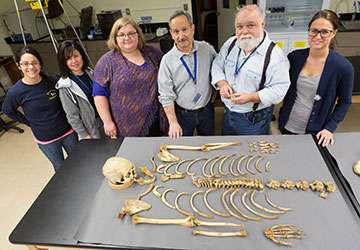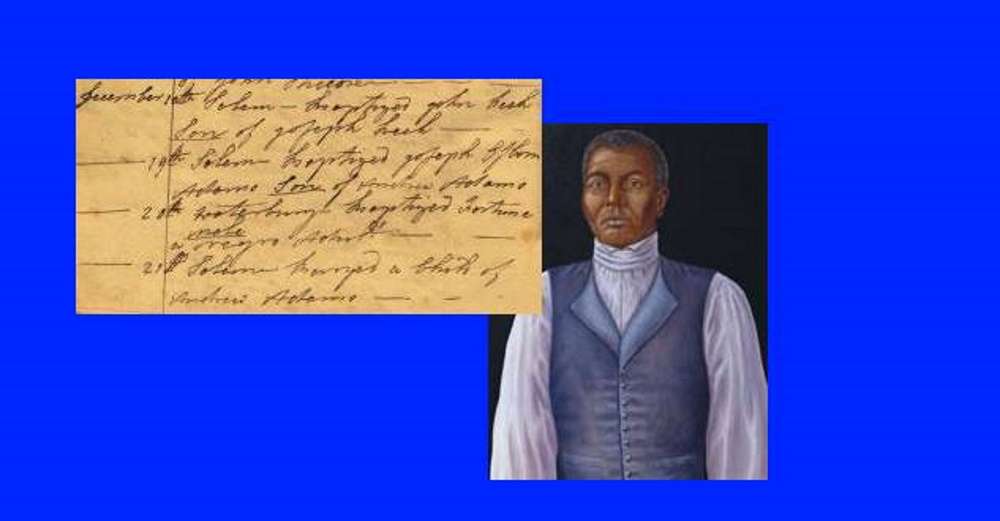More than 200 years after his death, a Waterbury, Conn., slave received a proper burial. His name is Fortune, and his journey to this point starkly illustrates the timeline of changes in the way people viewed New England slavery since he died in 1798.

From the Mettatuck Museum’s Fortune’s Story Exhibit. Fortune as he may have looked in life. Painted by William Westwood, a medical illustrator, based on Fortune’s skeleton.
Upon his death, Fortune’s owner Dr. Preserved Porter decided to make use of his remains at his “School for Anatomy.” After Fortune died by the Naugatuck River, Dr. Porter personally carried out the gruesome process of reducing Fortune to a skeleton. The slave’s remains served as a medical teaching tool for decades.
In 1933, the Porter family gave the skeleton to the Mattatuck Museum, which displayed it as a curio from the days of New England slavery until 1970. Then the museum removed it from display, beginning a 40-year period during which no one knew quite what to do with Fortune.
Used for medical research, subjected to vandalism and mockery and finally shoved in a basement for more than 20 years, Fortune’s history is shameful. And his state in 2013 no doubt resulted from unethical behavior.
But since righting the original wrongs done to him is not possible, his fate created a conundrum. His guardians had to try to decide what to do with the remains of someone born into New England slavery around 1740. What would he want to happen to his remains today in their current condition?
No one could determine the answer with any degree of certainty. But on Sept. 12, 2013, Fortune received a proper burial, hopefully the best outcome possible.
New England Slavery
While never as prevalent in New England as it was in the South, New Englanders did indeed practice slavery.
The 1790 census showed the scope of New England slavery.
| Colony | Number of slaves | |
| Connecticut | 2648 | 1790 Census |
| Massachusetts | 4500 | 1754 Census |
| New Hampshire | 157 | 1790 Census |
| Rhode Island | 958 | 1790 Census |
| Vermont | 16 | 1790 Census* |
*This figure is subject to dispute.
Outlawed by 1784, New England slavery wasn’t completely extinguished until the mid-1800s. But Fortune was, nevertheless, one of the later slaves in New England.
How did Fortune die? There are theories, legends and precious little known about the answer to that question.
His death is documented. Local lore suggested that he had been trying to escape when he was killed. Other stories say he drowned in the Naugatuck River, by accident. Either way, he wound up a scientific specimen.
Heirloom
Today physicians afford people a great deal of control over what experiments are performed on them and how their remains are disposed. Fortune, however, belonged to the unfortunate class of people for whom there was no say.
There were laws against dissection of human cadavers, and the practice was controversial. Some places outlawed it completely. In Massachusetts, certain executed criminals could be dissected. But for slaves, it was as simple as Dr. Proctor taking Fortune’s body to a remote spot, hacking it up, boiling it down and putting the skeleton in his medical school.
It’s certain that the skeleton was put to good use in educating future doctors, but after Proctor’s death it was apparently relegated to the status of unusual family heirloom.
New England Slavery Remembered
In 1930, the skeleton had been reconstructed, with the bones labelled, and donated to the museum. Along the way, someone scrawled the name “Larry” on Fortune’s skull. In the 1940s, the museum put it on display to highlight Waterbury part in New England slavery as well as the medical school.
For purposes of the exhibit, and commemorative postcards, he became “Larry the Skeleton.”
He remained a fixture in the museum until 1970 when someone tactfully suggested it might not be appropriate to continue displaying his remains. So they were tucked away, secure in the basement. And there they stayed for more than 20 years.
Skeletons in the Basement

Quinnipiac faculty, staff, and students use diagnostic imaging techniques to learn more about Fortune and his life in New England slavery.
After a Waterbury black history publication started up that Fortune again came to light. The researchers who had pulled together the story of early African Americans in Waterbury received in the mail one of the old “Larry the Skeleton” postcards, according to the Episcopal News Service. They decided to look further into the matter.
With that, the museum faced the conundrum. People had undoubtedly subjected Fortune to a laundry list of indignities. But what would he want now?
There is, of course, no way Fortune would have ever imagined his fate. With no guidance, the museum began an exhibit and did its best to restore Fortune’s dignity. It shepherded him off to a better fate than the basement.
Using DNA and computer software that can guide facial reconstruction, they tried to bring his story to life. Artists did their best to recreate his likeness. A full symphony and choir performed a cantata based on an elegy written to honor his memory.
Respectful Burial
Diagnostic imaging tools were employed to learn all that could be learned about his life. Scientists discovered that he had injured his neck, which may have caused his death. But nothing indicated that someone had killed him.
And researchers attempted in vain to find his ancestors in the hopes that they could consult them about what to do with his remains. Fortune had a wife and four children, but the researchers discovered no descendants.
In the end, the museum returned to the church that baptized Fortune in the year before his death. They asked the Episcopal priest if she would perform his funeral. The Rev. Amy Welin agreed.
“When I realized he had been baptized at St. John’s, I thought, ‘Oh my heavens, this man is actually my parishioner!’” she told the Episcopal News Service. “We are giving a parishioner the decent and respectful burial that he was denied 215 years ago.”
This story about New England slavery was updated in 2022.
